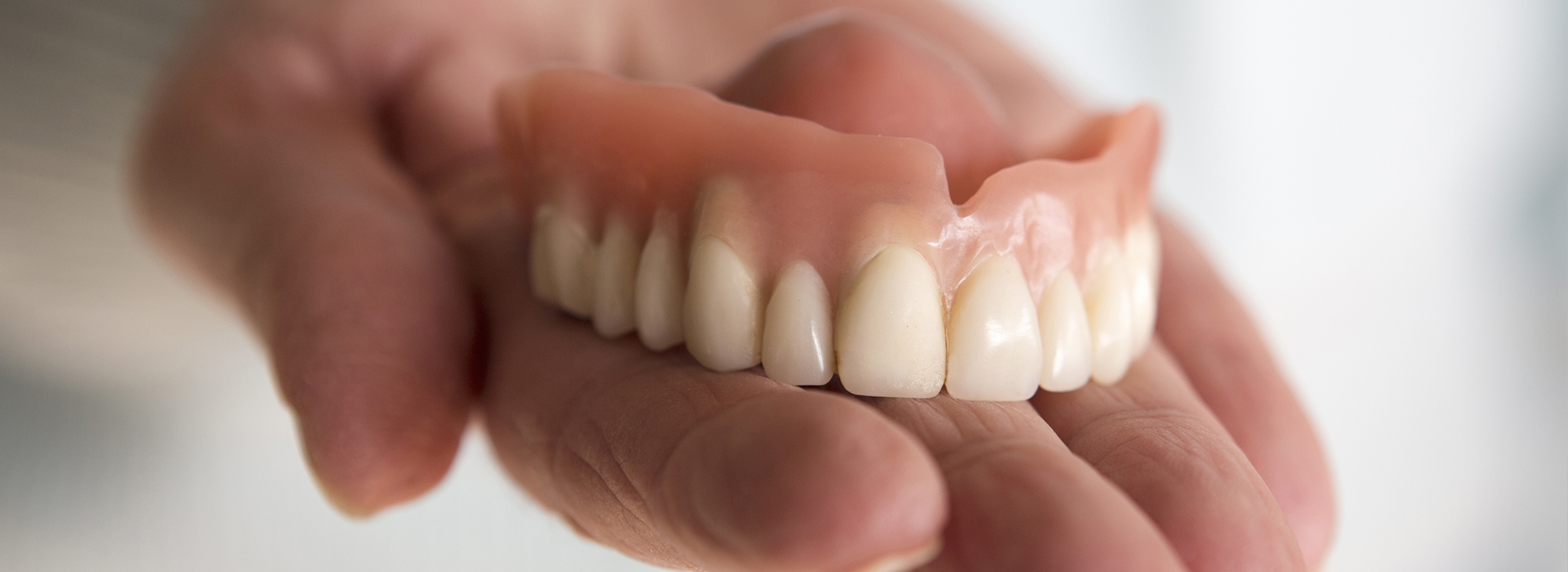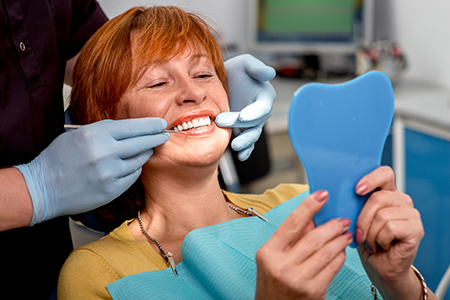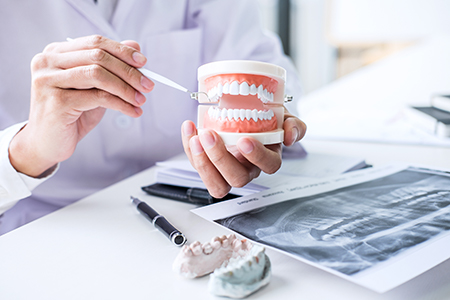Existing Patients
(740) 393-2161
New Patients
(740) 200-4777

Advances in dental materials and clinical techniques have made replacing missing teeth more predictable and natural-looking than ever. While dental implants and fixed bridgework offer durable, permanently anchored options, removable dentures remain a practical and widely used choice for restoring a complete smile and daily function.
At Brian Howe DDS, Family Dentistry, we design and craft dentures using high-quality materials and established fabrication methods to achieve a comfortable fit and an attractive appearance. Our goal is to provide prosthetics that restore speech, chewing ability, and facial support while looking balanced and natural within each patient’s smile.
Every denture case begins with a careful evaluation of oral health, remaining teeth, and personal priorities. We focus on solutions that fit a patient’s lifestyle and clinical needs, helping people regain confidence and the ability to enjoy meals, conversations, and social life without hesitation.
Losing teeth affects more than just appearance. Gaps in the dental arch can make it harder to speak clearly and limit the variety of foods a person can eat comfortably. Over time, missing teeth can alter bite relationships, causing neighboring teeth to tilt or drift and increasing the risk of further wear and dental problems.
There are also consequences beneath the gum line: the jawbone loses stimulation when teeth are missing, which gradually changes facial contours and can lead to a sunken or aged look. Addressing tooth loss helps protect remaining teeth, maintain oral function, and preserve the structure that supports the face.
Because the effects of tooth loss are progressive, many clinicians recommend timely restoration when appropriate. Whether replacing one tooth or a full arch, partial and complete dentures offer a reliable path to reestablishing oral function and aesthetic balance while supporting overall dental health.

Dentures are removable dental appliances made of artificial teeth set into a supportive base that rests against the gums. They are designed to replace either a segment of missing teeth (partial dentures) or an entire upper or lower arch (complete dentures). Properly designed dentures restore basic form and function while improving the visual harmony of the smile.
Unlike permanently fixed restorations, removable dentures can be taken out for cleaning and overnight rest. This removability makes it easier to maintain oral hygiene for the mouth’s soft tissues and any remaining natural teeth, and it also simplifies routine denture care.
Modern denture materials and precision fabrication techniques allow for improved aesthetics and comfort. When stability is a concern, dentures can be paired with attachments on retained teeth or with strategically placed dental implants to enhance retention and reduce movement during chewing and speaking.
Selecting the right denture type depends on how many natural teeth remain, the health of those teeth, and the condition of the gums and supporting bone. A thorough clinical exam and imaging help guide this decision so the final prosthesis meets functional and cosmetic goals.
Complete or full dentures replace all teeth in the upper arch, lower arch, or both. They rely on close adaptation to the gums and underlying bone for retention and are custom-shaped to restore lip and cheek support, reestablish bite height, and create a pleasing smile line.
A conventional full denture is fabricated after any remaining teeth are removed and tissues have healed. This sequence allows the dental team to shape the prosthesis to the healed contours, which can improve fit and comfort over the long term.
Immediate dentures
Immediate dentures are placed on the same day as extractions so the patient does not go without teeth during healing. While they provide instant restoration, they often need adjustment as tissues remodel and may require relining or replacement later to maintain an optimal fit.
Overdentures
An overdenture gains extra support from retained tooth roots or specially placed attachments on remaining teeth. This approach preserves bone and offers improved stability compared with a communal tissue-supported denture.
Implant-supported dentures
Implant-supported dentures are secured to implants inserted in the jawbone and provide a higher level of retention and chewing efficiency. Depending on the case, these dentures may snap or screw onto the implants and can dramatically reduce movement during function.
Partial dentures replace one or several missing teeth and attach to the remaining dentition using clasps or precision attachments. They help distribute chewing forces, maintain proper tooth alignment, and close unsightly gaps that can otherwise lead to drifting or overeruption of opposing teeth.
Contemporary partials are available in several materials—from traditional cast metal frameworks to flexible resin options—allowing for choices that prioritize comfort, esthetics, and durability based on a patient’s needs.
As your dental team evaluates options, the long-term health of any remaining teeth and the quality of surrounding bone play a central role in recommending the most appropriate denture design.
Successful denture treatment blends clinical assessment, skilled laboratory work, and patient input. The process typically begins with a comprehensive exam and diagnostic records to document oral anatomy, occlusion (bite), and facial proportions. These details guide the shape, tooth selection, and dimensions of the denture.
Impressions and bite registrations are taken to capture how the jaws relate and where the teeth should sit for proper function. Multiple try-in appointments may be scheduled to verify tooth position, color, and the way the denture interacts with lip and cheek soft tissues before the final prosthesis is processed.
In some cases, extractions or minor procedures are recommended before fabricating a denture to create an optimal foundation. When implants are part of the treatment plan, surgical placement and a healing period precede attachment of an implant-retained prosthesis. The goal at every step is a denture that feels stable, performs reliably, and looks natural within each patient’s face.
The result—when planning and execution are aligned—is a prosthesis that restores everyday function and helps preserve facial support, allowing patients to smile, speak, and eat with renewed ease.

Adapting to a new appliance
New dentures often require an adjustment period. Speaking and chewing may feel different at first; most people adapt within days to weeks. Regular follow-up appointments allow the dental team to make necessary reliefs and refinements for comfort and function.
Temporary changes such as increased saliva
It’s common to notice heightened salivation when a denture is first introduced. This response diminishes over time as the mouth acclimates to the prosthesis.
Speaking and eating with confidence
Reading aloud and practicing common sounds can speed speech adaptation. For eating, begin with soft, well-cut foods and chew slowly using both sides of the mouth. Over time, most people regain the ability to enjoy a broad variety of foods.
Cleaning and daily maintenance
Rinse dentures after eating and brush them daily with a brush designed for prosthetics to remove food particles and plaque. Use a recommended cleanser periodically to keep the appliance fresh.
Continue to care for any remaining natural teeth and gently clean the gums and palate to support healthy tissues beneath the denture.
Remove dentures at night to give the oral tissues a chance to recover and help prevent irritation. When not worn, keep dentures moist in water to preserve their shape.
Options for added stability
For patients who experience movement or lack of retention with tissue-supported dentures, adhesive products or implant-supported attachments are available to enhance stability and confidence during function.
Continuing care and periodic adjustments
Routine dental visits are essential to monitor fit, oral health, and the condition of any remaining teeth. As the shape of the jaw changes over time, relines or remakes may be recommended to restore optimal fit and comfort.

Dentures are a versatile solution for restoring missing teeth and reestablishing oral function. Whether you need a partial that integrates with remaining teeth, a conventional complete denture, or a denture that benefits from implant support, careful planning and skilled fabrication are the keys to a successful outcome.
Our team partners with patients throughout the process—evaluating clinical needs, explaining options in clear terms, and tailoring care so the final prosthesis fits both physically and visually within each person’s lifestyle.
If you’re considering dentures or want to review how to improve the fit and performance of an existing prosthesis, contact our office for more information and to schedule a consultation. We’re here to help you make a confident, informed decision about restoring your smile.
Dentures are removable dental prostheses that replace missing teeth and the supporting structures around them. They recreate tooth form and bite relationships so patients can speak and chew with improved comfort and efficiency. Well-designed dentures also restore facial support and help maintain a natural appearance by replacing lost tooth height and lip contour.
The success of denture treatment depends on careful assessment of oral tissues, remaining teeth, and bite alignment. Proper fit and occlusion minimize sore spots and improve chewing ability, while routine follow-up allows the dental team to refine the prosthesis as tissues change. With modern materials and technique, many patients regain functional confidence and a pleasing smile.
The primary denture categories are complete (full) dentures, partial dentures, and hybrid or implant‑retained options. Complete dentures replace all teeth in an arch and rely on tissue adaptation and suction, whereas partial dentures fill gaps when some natural teeth remain and attach with clasps or precision fittings. Hybrid solutions combine a removable prosthesis with dental implants or retained tooth roots to increase stability and preserve bone.
Within these categories are variations such as immediate dentures placed at the time of extraction, overdentures that use retained roots for support, and flexible partials that prioritize comfort. Material choices and attachment methods are selected based on the patient’s oral health, functional needs, and esthetic goals. A comprehensive exam and diagnostic imaging help determine the most appropriate type for each case.
Treatment begins with a thorough clinical exam that evaluates teeth, gums, jawbone, and bite relationships. Diagnostic records—such as impressions, bite registrations, and, when indicated, radiographs—are used to plan tooth position, occlusion, and facial support. The team discusses options and sequence of care, which may include extractions or preparatory procedures prior to fabrication.
Once the plan is finalized, impressions and try‑in appointments verify fit, tooth selection, and esthetics before the final prosthesis is processed. After delivery, initial adjustments and follow‑up visits are scheduled to relieve pressure points and fine‑tune function. Ongoing care may include relines or remakes as oral tissues remodel over time.
Conventional dentures are fabricated after extractions and tissue healing to match the settled contours of the mouth, which often improves long‑term fit. Immediate dentures are inserted at the time of tooth removal so the patient is not without teeth during healing; they provide instant replacement but usually require adjustments or relines as tissues remodel. Implant‑supported dentures are anchored to dental implants in the jaw and offer superior retention and chewing function compared with tissue‑supported prostheses.
Each approach has distinct advantages and considerations: conventional dentures prioritize long‑term fit, immediate dentures offer immediate esthetic benefit during healing, and implant‑supported solutions increase stability and reduce movement. The choice depends on the patient’s oral health, bone volume, medical history, and functional expectations, all of which are reviewed during treatment planning.
Good candidates for removable dentures include patients with multiple missing teeth or complete tooth loss who seek to restore function and appearance without fixed restorations. Candidates should have healthy oral tissues or be able to undergo necessary preparatory care such as periodontal treatment or extractions. Bone volume, the condition of remaining teeth, and general health are important factors in determining suitability for different denture types.
When greater stability is desired, patients with sufficient bone and overall health may be candidates for implant‑retained dentures, while those who prefer a non‑surgical option can often benefit from well‑designed tissue‑supported or precision‑attachment partials. A comprehensive consultation identifies the safest and most predictable option tailored to each patient’s clinical situation and lifestyle.
Daily denture care begins with rinsing the appliance after eating and brushing it gently with a soft prosthetic brush and a nonabrasive cleanser to remove plaque and food debris. Patients should also clean any remaining natural teeth, gums, and the palate to maintain tissue health and reduce irritation beneath the denture. Removing dentures at night gives oral tissues a chance to recover and helps prevent sore spots and fungal overgrowth.
When not in use, dentures should be stored in water or a recommended soaking solution to preserve shape and prevent drying. Regular dental checkups allow the clinician to evaluate fit and tissue health, perform professional cleans, and make adjustments or relines as needed. Proper daily care combined with routine professional oversight helps extend the life and comfort of the prosthesis.
Implant attachments transfer retention to osseointegrated implants rather than relying solely on gum adaptation, which significantly reduces movement during speech and chewing. By anchoring the denture with locators, bars, or screw connections, implant‑retained prostheses provide improved chewing efficiency, greater confidence, and often a closer approximation of natural tooth function. Attachments also distribute biting forces to the bone, helping to preserve volume and long‑term facial support.
The number and placement of implants depend on the arch involved, bone quality, and the prosthesis design; strategic planning with radiographic imaging ensures predictable outcomes. At Brian Howe DDS, Family Dentistry, our team evaluates implant suitability and coordinates placement and restoration so patients receive a stable, well‑fitting solution when implants are clinically appropriate.
An adjustment period is normal as the mouth learns to accommodate the new appliance; speech may sound different and chewing patterns will change at first. Many patients adapt within days to a few weeks, and targeted practice—such as reading aloud and starting with soft, small pieces of food—speeds functional recovery. Initial sore spots or pressure areas can usually be relieved with simple adjustments during follow‑up visits.
Transitional symptoms like increased saliva production or mild irritation typically subside as tissues acclimate to the prosthesis. Persistent discomfort, sore areas that worsen, or difficulty with retention should be reported to the dental team promptly so refinements or relines can be made. Close communication during this phase helps ensure a comfortable, long‑term fit.
Dentures and oral tissues should be evaluated at least annually, or more frequently if the patient reports fit problems, discomfort, or changes in chewing ability. Regular examinations allow the clinician to monitor tissue health, assess wear on the prosthesis, and check for signs of bone or soft‑tissue changes that affect fit. Early detection of fit issues reduces the risk of sore spots and helps maintain oral function.
Relines may be recommended when the denture no longer adapts closely to the gums due to natural bone remodeling, typically several years after delivery depending on individual changes and wear. In addition to relines, some patients will eventually require a remake to restore optimal support and esthetics; routine visits ensure timely care and prolonged prosthesis performance.
Dentures alter oral contours and tongue space, so temporary changes in speech—especially with sounds like "s" and "f"—are common until the mouth adapts. Practicing speaking slowly, reading aloud, and repeating challenging words helps accelerate adjustment. For eating, begin with soft, well‑cut foods and chew on both sides of the mouth to stabilize the denture; gradually reintroduce firmer items as confidence and control improve.
Using denture adhesives or considering implant retention can further stabilize the appliance for difficult foods, but patients should always follow their clinician’s guidance on safe adaptation strategies. If speech or chewing concerns persist, scheduled follow‑up visits allow the dental team to evaluate fit and make targeted modifications to improve comfort and function.
Our friendly and knowledgeable team is always ready to assist you. You can reach us by phone at (740) 393-2161 or by using the convenient contact form below. If you submit the form, a member of our staff will respond within 24–48 hours.
Please do not use this form for emergencies or for appointment-related matters.
